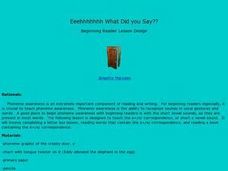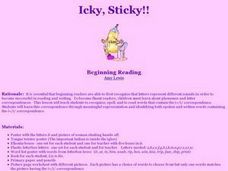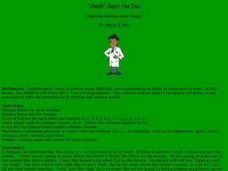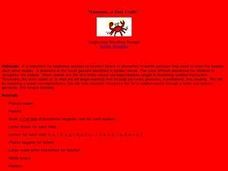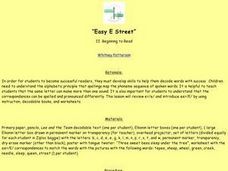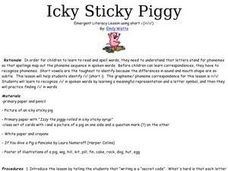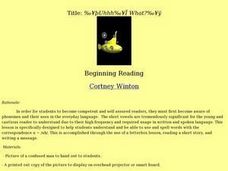Curated OER
Eddie the Elephant
Young scholars need to practice sight words to become proficient readers. So it is very important for children to learn common correspondences. The phoneme for the letter "e" is practiced in this lesson.
Curated OER
Eeehhhhhhh What Did you Say??
Student read pseudo words containing the e=/e/ correspondence and recognize sounds in vocal gestures and words. They explore the e=/e/ correspondence, or short e vowel sound and complete a letter box lesson, reading words that contain...
Curated OER
Unopened Umbrella
Students explore vowel correspondences. They discuss the vowel correspondence u=/u/. They identify u=/u/ in written words and a meaningful representation and letter symbol for the sound. Students read and write words using u=/u/.
Curated OER
Lizzy the Icky Sticky Lizard
First graders recognize the short vowel i in written and spoken language. Through listening activities, they discriminate the vowel sound /i/ from other phonemes. Students associate the phoneme with its letter representation and identify...
Curated OER
Olly Olly Oxenfree
Students review short vowel sounds. They complete a variety of activities as they discover how to say the short /o/ sound, write the letter 'o', and pronounce words with the short /o/ sound. They read stories with short /o/ words in them.
Curated OER
The Squeaky Creaky Elevator
Learners engage in an emergent literacy lesson in order to help develop the skills of letter recognition and corresponding sound of the phoneme. This is done with the use of a tongue twister using the phoneme of the letter "e".
Curated OER
Lizzy the Icky Sticky Piggy
Students read and spell words using the short letter "I". They become familiar with the letter "I" in spoken words by a meaningful representation and a letter symbol. Students come up with words with the sound and review the tongue...
Curated OER
Listen Up!
Students explore the short /e/ sound. They practice writing the letter 'e' and making the short /e/ sound. They recite an 'e' tongue twister and practice finding the short /e/ sound in spoken words. They identify pictures of words...
Curated OER
Uh, Bugs
Students recognize the short vowel u in written and spoken language. Through listening activities, they discriminate the vowel sound /u/ from other phonemes. Students associate the phoneme with its letter representation and identify the...
Curated OER
"Aaaaaa!!!!" Please Don't Cry Baby!
Students complete a variety of activities as they examine the letter 'a' as it makes the short /a/ sound. Through instruction and modeling, they explore the sound the letter makes and how the letter is written. They recite tongue...
Curated OER
Icky-Sticky
Pupils practice recognizing the connection between phonemes and letters with an emphasis on finding the short vowel /i/ in words. They each receive a Elkonin letterbox and a picture card with icky-sticky gum on it and the letter i.
Curated OER
"Aaah" Says the Doc
Students complete a variety of activities as they explore/review the letter 'o' as it makes the short /o/ sound. They recite short /o/ tongue twisters, practice writing the letter 'o', and listen to stories, identifying words with the...
Curated OER
Icky Sticky Inchworm
Young scholars examine the letter 'i'. Through instruction and modeling they explore the sound the letter makes, how the letter is written, words that contain the letter, etc. They use letterboxes to write 'i' words and read stories...
Curated OER
"Aaaaaaa...a Fast Crab! "
Students participate in an emergent literacy lesson that focuses on the skill of phonemic awareness. The phoneme chosen is the letter "a". They need to correlate the sound to the letter.
Curated OER
The Struggle to Organize
High schoolers analyze correspondence and a news release regarding the Harlan, Kentucky, mine strike of 1931-1932. They use these documents to discuss the problems of organizing industrial trade unions before the New Deal.
Curated OER
Pop, Pop, Popcorn
Students study the letter 'p' in both written and spoken word. They practice making the /p/ sound before reciting a tongue twister and writing the letter. Next, they listen to a read aloud of Charles Pomerantz, "Piggy in the Puddle"...
Curated OER
Beginning Reading Lesson: Aaa-aaa-aaa-choo!!
Students study the letter sound recognition for the /a/ by recognizing the sound one makes when they sneeze. They use a chart with a tongue twister on it and work with letterboxes and manipulative letters that focus on words with the...
Curated OER
E-E-E-E-Extra E-E-E-E-Effort
Pupils listen to a tongue twister emphasizing the short e sound. They practice writing the letter e and attaching different words with that sound to it. They listen to a book about a dog that enhances the letter e. They write a...
Curated OER
"Easy E Street"
Learners investigate how the same letter can make more than one sound. It is also important for students to understand that the correspondences can be spelled and pronounced differently. This lesson will review e=/e/ and introduce ee=/E/...
Curated OER
AAA!! The Baby is Crying! AAA!!
First graders take out primary writing paper and review how to form the letter "a". They observe a large picture of a baby crying on the board, discuss it and make the sound a baby makes when it is crying. They listen to some words,...
Curated OER
Icky Sticky Piggy
Young scholars examine the letter 'i' and the short /i/ sound. Through instruction and modeling they explore how to make the short /i/ sound, how the letter 'i' is written, etc. They recite tongue twisters and read stories and pick out...
Curated OER
Chicka, Chicka, Choo, Choo
Students begin to read and spell words vis phonemes and letter correspondences. They encounter the concept digraph. This lesson helps the students see a c and h together, they make the ch sound. So, that the students recognize this...
Curated OER
Uhhh..What?
Students identify and become competent and in reading the letter u, pronounced /uh/. They also use and spell words with the correspondance u = /uh/ by the use of a letterbox lesson, reading a short story, and writing a message.
Curated OER
A Tisket-A-Tasket, Let?s Make a Flower Basket!!!
First graders practice blending words with the phonemes /i/ and /e/. Working with a specific groups of letters, 1st graders create words using the vowels i and e. they decode those words and read them repeatedly to increase fluency.
Other popular searches
- Letter Sound Correspondence
- Letter Sounds Correspondence
- Letter Sound Correspondence
- Letter Correspondence
- Letter/sound Correspondence

